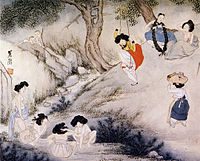Dance:
 |
| Korean Genja |

As with music, there is a distinction between court dance and folk dance. Common court dances are jeongjaemu (정재무) performed at banquets, and ilmu (일무), performed at Korean Confucian rituals.
Jeongjaemuis divided into native dances (향악정재, hyangak jeongjae) and forms imported from Central Asia and China (당악정재, dangak jeongjae). Ilmu are divided into civil dance (문무, munmu) and military dance (무무,mumu).
The traditional clothing is the genja, it is a special kind of dress that women wear on festivals. It is pink with multiple symbols around the neck area.
Painting:

The earliest paintings found on the Korean peninsula are petroglyphs of prehistoric times. With the arrival of Buddhism from India via China, different techniques were introduced. These techniques quickly established themselves as the mainstream techniques, but indigenous techniques still survived.
In the 18th century indigenous techniques were advanced, particularly in calligraphy and seal engraving.

Crafts:
-There is a unique set of handicrafts produced in korea.
-Most of the handicrafts are created for a particular everyday use, often giving priority to the practical use rather than aesthetics.
-Traditionally, metal, wood, fabric, lacquerware, and earthenwarewere the main materials used, but later glass, leather or paper have sporadically been used.
-Ancient handicrafts, such as red and black pottery, share similarities with pottery of Chinese cultures along the Yellow River
